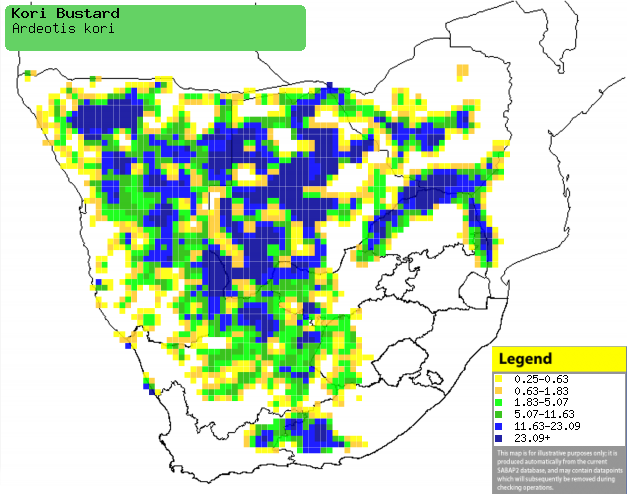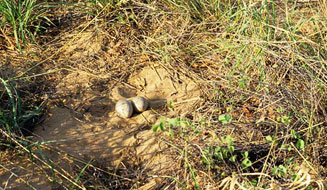|
Ardeotis kori (Kori bustard)
Gompou [Afrikaans]; Iseme (generic term for bustard)
[Xhosa]; umNgqithi [Zulu]; Epwezampundu (generic term for bustard) [Kwangali];
Kgori [North Sotho]; Ngomanyuni [Shona]; Mithisi [Tsonga]; KgŰri, ThulakomÍ
[Tswana]; Koritrap [Dutch]; Outarde kori [French]; Riesentrappe [German];
Abetarda-gigante [Portuguese]
Life
> Eukaryotes >
Opisthokonta
> Metazoa (animals) >
Bilateria >
Deuterostomia > Chordata >
Craniata > Vertebrata (vertebrates) > Gnathostomata (jawed
vertebrates) > Teleostomi (teleost fish) > Osteichthyes (bony fish) > Class:
Sarcopterygii (lobe-finned
fish) > Stegocephalia (terrestrial
vertebrates) > Tetrapoda
(four-legged vertebrates) > Reptiliomorpha > Amniota >
Reptilia (reptiles) >
Romeriida > Diapsida > Archosauromorpha > Archosauria >
Dinosauria
(dinosaurs) > Saurischia > Theropoda (bipedal predatory dinosaurs) >
Coelurosauria > Maniraptora > Aves
(birds) >
Order: Gruiformes
> Family: Otitidae
The Kori bustard has two subspecies, with one occurring in
north-eastern Africa, while the other mainly occurs in southern Africa, living
in a wide variety of mainly dry habitats. It eats a wide variety of animals and
plant products, often eating hard materials, such as stones, pieces of bones and
even bullet shells and broken glass! The male does a courtship display to
multiple females, after which it mates with some of them, all incubating and
parenting are left to be done by the female. The 1-2 chicks are able to fly when
they are 3-4 months old, but they remain dependent on their mother until the
following breeding season, when they are 12-18 months old.
Distribution and habitat
It has two subspecies, living in two
different parts of Africa. Ardeotis kori struthiunculus (Somali kori
bustard) occurs in north-eastern Africa, whereas Ardeotis kori kori
occurs mainly in southern Africa, extending into Angola and
south-western Zambia. In southern Africa it is locally common in Namibia,
Botswana, Zimbabwe and west-central South Africa. It generally prefers dry,
open savanna, Nama karoo, dwarf shrublands, occasionally moving into grassland and dense,
closed-canopy woodland.
|
 |
|
Distribution of Kori bustard in southern Africa,
based on statistical smoothing of the records from first SA Bird Atlas
Project (©
Animal Demography unit, University of
Cape Town; smoothing by Birgit Erni and Francesca Little). Colours range
from dark blue (most common) through to yellow (least common).
See here for the latest distribution
from the SABAP2. |
Predators and parasites
Food
It eats a wide variety of animals and plant
products, foraging by walking around and plucking food items from the ground,
low bushes and trees. The following food items have been recorded in
its diet:
- Animals
- Invertebrates
- Vertebrates
- reptiles
- bird eggs and nestlings
- small rodents
- carrion
- Plant matter
- seeds
- berries
- roots
- bulbs
- flowers
- wild melons
- Acacia gum
- leaves
- grass
- Grit
- It sometimes swallows pieces of grit, with one stomach containing the
following:
- stones
- pieces of bones
- one 12-bore shotgun shell
- two Bullet shells
- 4.5 x 4.5 cm piece of flat metal
- Another stomach contained:
- 60 g of Broken grass
- Part of a plastic tail light
Breeding
- Polygynous, territorial solitary nester, meaning that one male mates with
multiple females. The male does a courtship display to multiple females,
usually in early morning or late afternoon, in which he
struts around with his head cocked, bill open and its neck inflated four
times, all while giving a booming call.
- The nest is a shallow scrape in the ground, often reusing the same site
in multiple breeding seasons.
 |
|
|
Kori bustard nest with eggs, Lephalele, South
Africa. [photo Warwick Tarboton ©] |
|
- Egg-laying season is from July-April, peaking from October-February.
- It lays 1-2 eggs, which are incubated by solely by the female for 23-25
days, defending the eggs from any lurking predators by chasing them with its
head pointing downward.
- The mother solely takes care of the chicks, who are able to fly when
they are 3-4 months old. They remain dependent on their mother until the
following breeding season, when they are 12-18 months old. The chicks are
eaten by the following animals:
Threats
Vulnerable in South Africa, largely due to habitat loss,
poisoning, deliberate snaring and hunting by dogs. Its range and abundance have
decreased in Zimbabwe, southern Mozambique and in the Eastern Cape, and is now
common only in large protected areas.
References
-
Hockey PAR, Dean WRJ and Ryan PG (eds) 2005. Roberts
- Birds of southern Africa, VIIth ed. The Trustees of the John Voelcker
Bird Book Fund, Cape Town.
|
